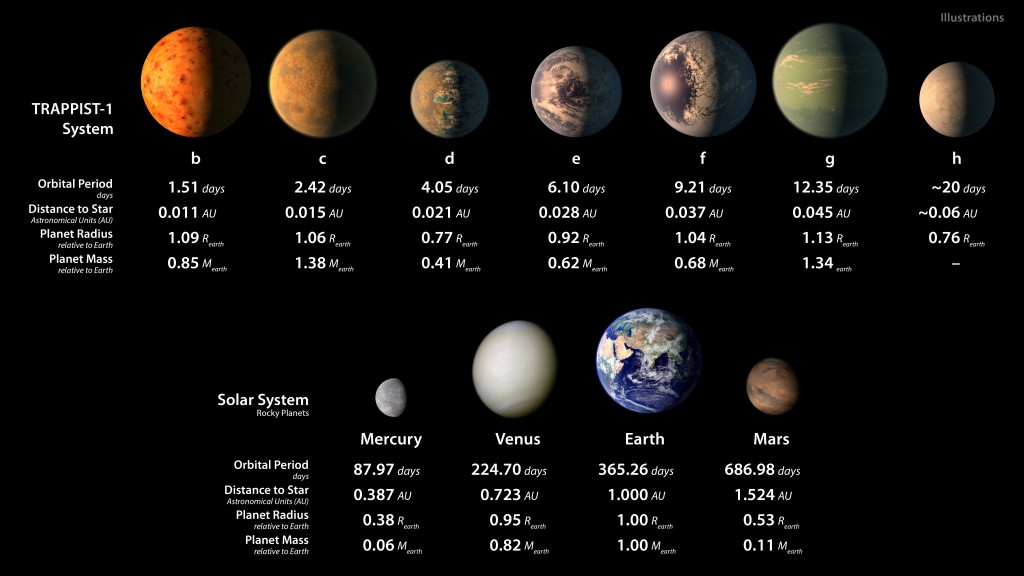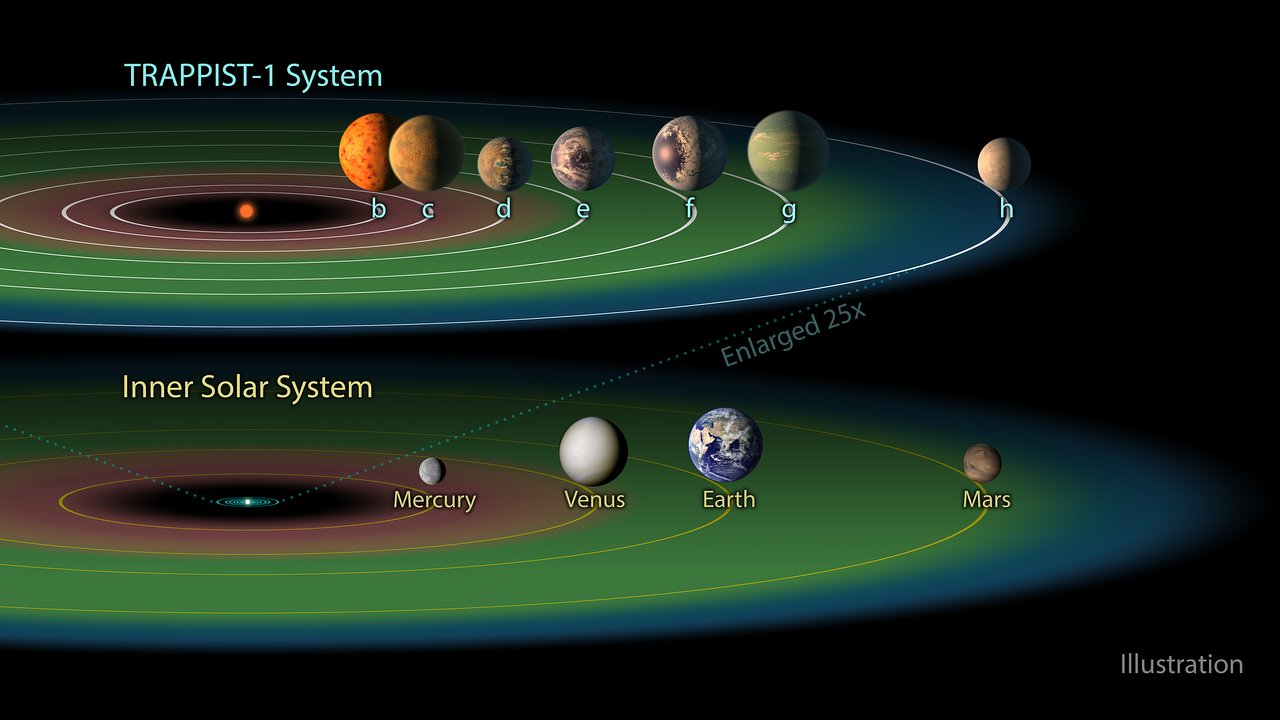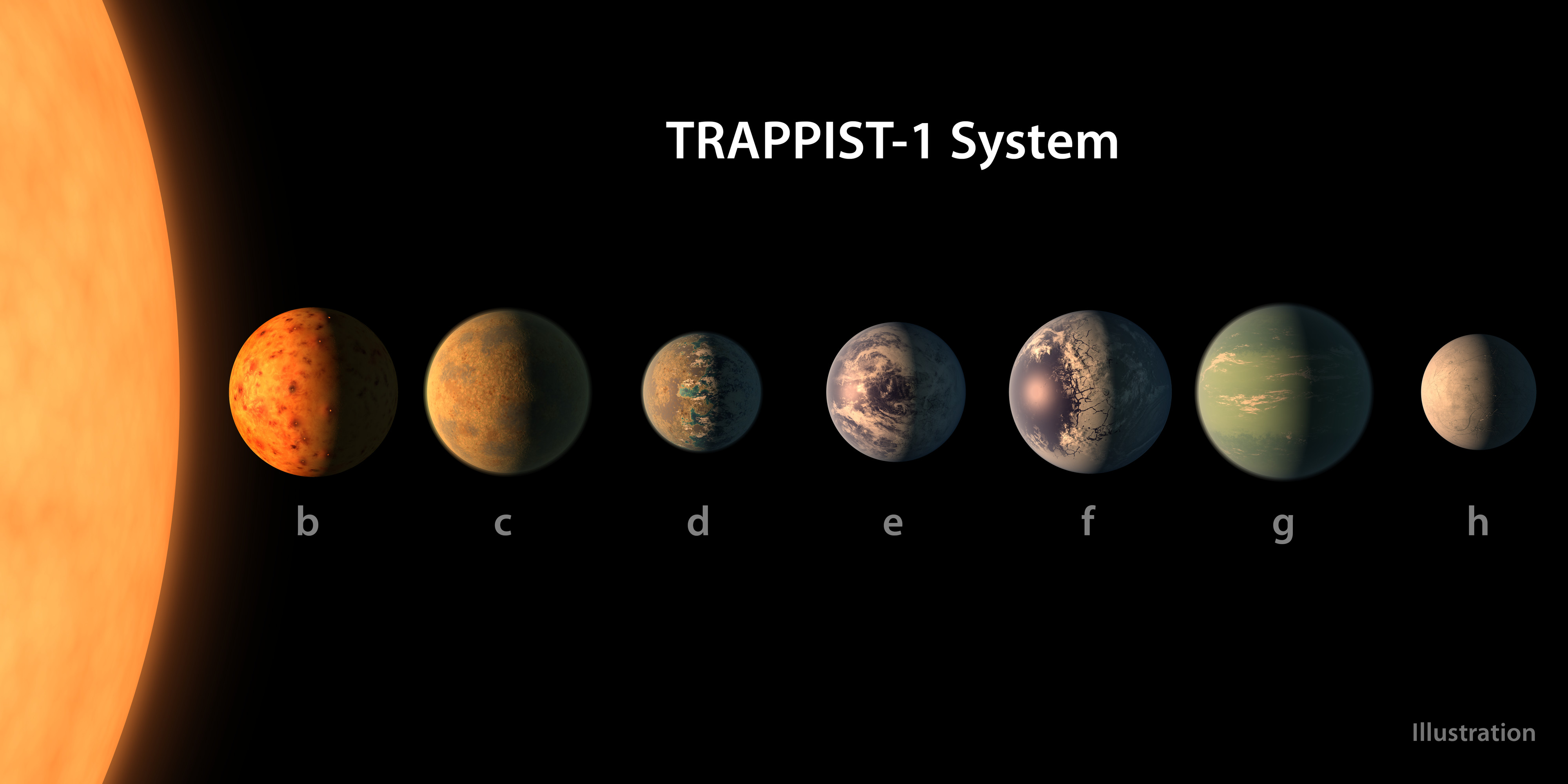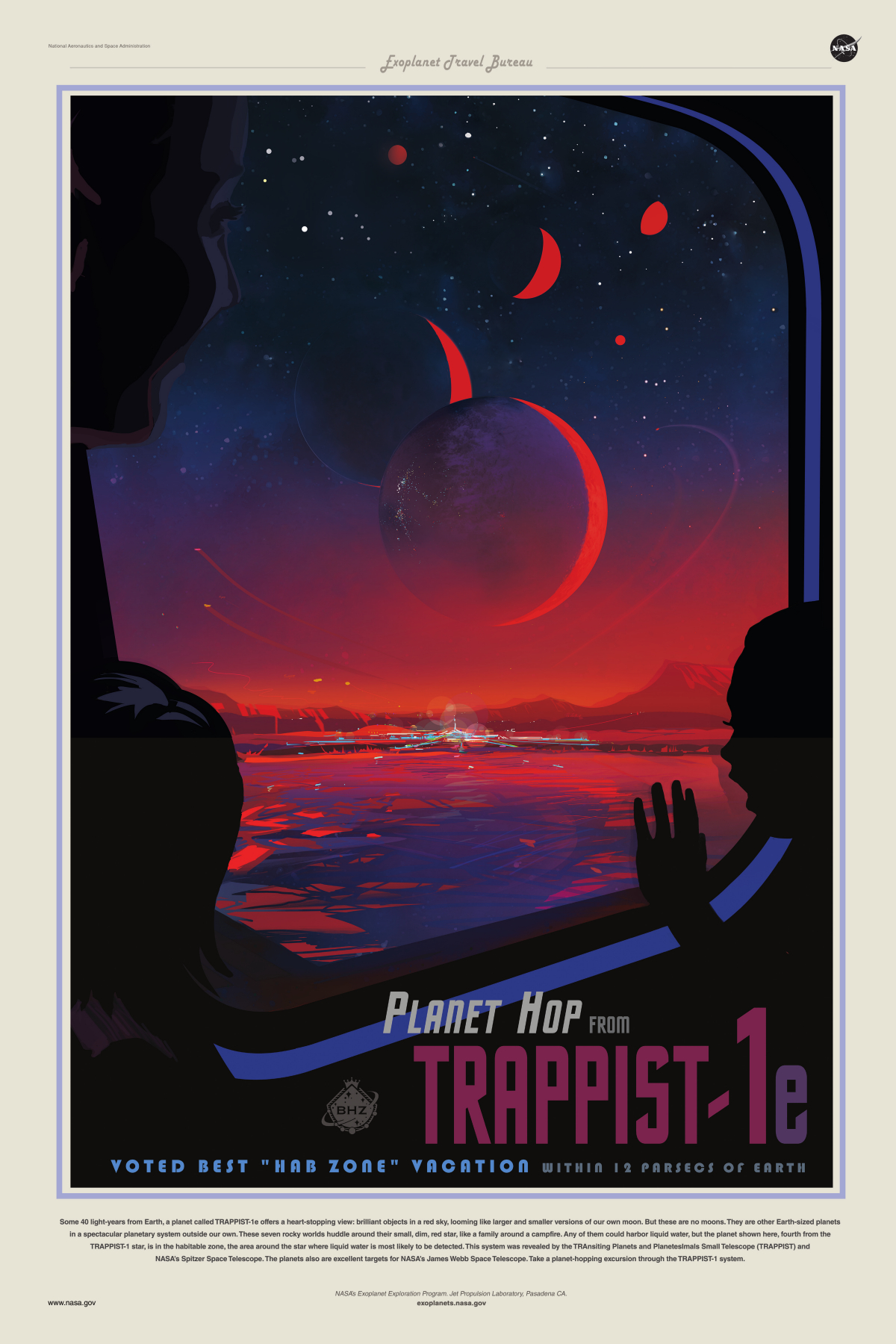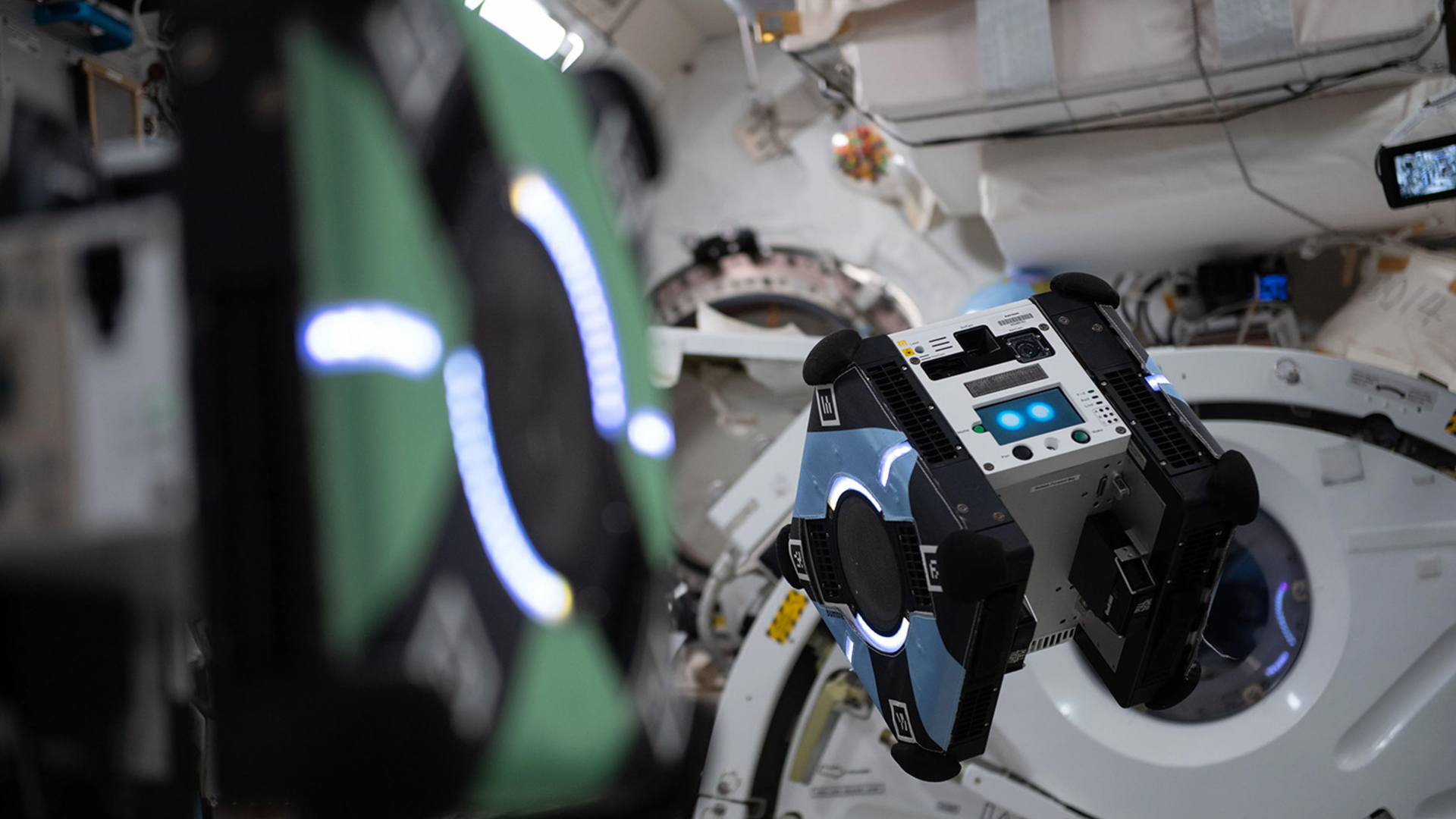TRAPPIST-1: A guide to the system with 7 Earth-size exoplanets
The seven worlds of TRAPPIST-1 are the most intriguing exoplanetary system discovered so far. What are these planets like, and could they support life?

The seven worlds of the TRAPPIST-1 planetary system make up one of our best chances for finding extraterrestrial life beyond our solar system.
All seven planets are rocky worlds, ranging from about the size of Mars to a little larger than Earth.
Three or four of them reside within their star's habitable zone, meaning they orbit at the right distance to support liquid water on their surfaces.
Related: The 10 most Earth-like exoplanets
How far away is TRAPPIST-1?
The Trappist-1 system is located just 40 light-years away in the constellation Aquarius, within range of the James Webb Space Telescope (JWST). This means that JWST can probe the atmospheres of the TRAPPIST-1 planets (if they have atmospheres) and learn valuable information about what kinds of worlds they are and whether they really could support life. (The TRAPPIST-1 system is far too faint to be seen with the unaided eye.)
How were the planets of TRAPPIST-1 discovered?
TRAPPIST stands for "Transiting Planets and Planetesimals Small Telescope," which is actually a pair of telescopes: one at the European Southern Observatory's La Silla Observatory in Chile (TRAPPIST-South) and another at the Oukaïmeden Observatory in Morocco (TRAPPIST-North). They are operated as part of a joint project between the University of Liège in Belgium and the Geneva Observatory in Switzerland.
As its name suggests, the TRAPPIST project searches for transiting planets that orbit other stars. Astronomers can spot these exoplanets as they pass between Earth and their star, blocking some of their star's light. The amount of light they block tells us the size of the planets, and the frequency with which we see them blocking the starlight reveals the period and size of their orbits. It is the method the Kepler space telescope used to find thousands of exoplanets, and now the Transiting Exoplanet Survey Satellite employs this technique.
Breaking space news, the latest updates on rocket launches, skywatching events and more!
TRAPPIST-1 was the first system of transiting exoplanets to be discovered by the TRAPPIST project, back in 2016. At first, only three planets were identified, but follow-up observations in 2017 by NASA's Spitzer Space Telescope discovered four more worlds. NASA described the TRAPPIST-1 system as the first known system of seven Earth-size planets around a single star.
What type of star is TRAPPIST-1?
TRAPPIST-1 is a red dwarf star, also called an M dwarf. These are the coolest, least-massive stars, with masses ranging from about 0.08 to 0.6 solar masses, according to the Space Telescope Science Institute in Baltimore.
TRAPPIST-1 is one of the smallest known M dwarfs, with a diameter of 52,300 miles (84,180 kilometers — just 12% of the sun's diameter — and 8.9% the sun's mass. Radiating at 4,060 degrees Fahrenheit (2,237 degrees Celsius), TRAPPIST-1 is less than half the temperature of the sun's surface.
At 7.6 billion years old, TRAPPIST-1 is also about 3 billion years older than the sun. This is good news for any potential life on the planets around TRAPPIST-1. First, it means a lot of time has passed for life to have evolved. Second, younger red dwarfs are known for being very active, regularly unleashing powerful flares of radiation and bursts of high-energy X-rays. The older a red dwarf becomes, the less frequently these flares occur. However, the question is, has the star already damaged the orbiting planets? When the star was younger, the flares may have blown away these planets' atmospheres.
Eternal day and night
Planetary systems around red dwarf stars are drastically scaled-down compared with the solar system. The innermost of TRAPPIST-1's planets, TRAPPIST-1b, orbits at a distance of 1.07 million miles (1.72 million km), while the outermost planet, TRAPPIST-1h, orbits 5.78 million miles (9.3 million km) from the star. Compare those distances to our solar system, where the innermost planet, Mercury, orbits at an average of 36 million miles (58 million km from the sun. In fact, the TRAPPIST-1 system could fit inside the orbit of Mercury at least four times over.
However, being so close is not a bad thing. Because red dwarf stars are so cool, the habitable zone — the area around a star where temperatures are suitable for liquid water — is much closer in, and several TRAPPIST-1 planets fall into the habitable zone. However, because the planets are so close to their star, gravitational tidal forces from the star cause the rotational period of the planets around their axis to become synchronously locked with their orbits. In other words, one day (one rotation around their axis) on one of these planets is equal in length to one year (one rotation around their star).
As a result, the planets always show the same hemisphere to their star, meaning one hemisphere is in constant daylight and the other is in permanent night. This effect, called tidal locking, is the same phenomenon that causes our moon to always show the same face to Earth.
Trappist-1 planets
TRAPPIST-1b
TRAPPIST-1b, the innermost planet in the TRAPPIST-1 system, is a rocky world that's similar in size to Earth. With a diameter of 8,846 miles (14,236 km), TRAPPIST-1b is about 1.116 times larger than our planet and 1.374 times as massive, according to NASA. TRAPPIST-1b's surface gravity is 10% stronger than Earth's.
Orbiting at just 1.07 million miles (1.72 million km) from its star, TRAPPIST-1b completes one loop around its star every 1.5 Earth days. As the innermost planet in the system, TRAPPIST-1b is very hot, with a surface temperature of about 450 F (225 C) on its day side. This is too hot for life as we know it.
TRAPPIST-1c
Another world too hot to be habitable, TRAPPIST-1c has a measured surface temperature of 225 F (107 C). Laura Kreidberg, an astronomer at the Max Planck Institute for Astronomy in Germany, describes TRAPPIST-1c as being interesting because "it's basically a Venus twin: it's about the same size as Venus and receives a similar amount of radiation from its host star as Venus gets from the Sun."
With a diameter of 8,718 miles (14,030 km), TRAPPIST-1c is 1.097 times larger than Earth and 1.308 times as massive, and its surface gravity is just a shade below our planet's. It orbits TRAPPIST-1 every 2.4 Earth days at a distance of 1.47 million miles (2.36 million km).
TRAPPIST-1d
This diminutive world is one of the least massive exoplanets discovered anywhere so far, and it has a slim chance of being habitable. Orbiting at a distance of 2.07 million miles (3.33 million km) every 4.05 Earth days, TRAPPIST-1d is on the inner edge of the red dwarf's habitable zone, with the planet receiving 4.3% more starlight than Earth does from the sun.
TRAPPIST-1d has a diameter of 6,246 miles (10,050 km) — just 0.788 times that of Earth — and only 38.8% of Earth's mass. Its surface gravity is less than half our planet's gravitational pull, meaning it would be even more difficult for TRAPPIST-1d to hang onto its atmosphere. And even if it could, planetary scientists at the University of Washington who have modeled the TRAPPIST-1 system think TRAPPIST-1d would be more likely to have a runaway greenhouse effect like Venus than be habitable like Earth.
TRAPPIST-1e
The best chance for a habitable environment in the TRAPPIST-1 system is TRAPPIST-1e, which lies in the middle of the habitable zone at a distance of 2.73 million miles (4.4 million km) from its star, according to NASA. Orbiting every 6.1 Earth days, TRAPPIST-1e is smaller than Earth, with a diameter of 7,292 miles (11,736 km) — just 0.92 times our planet's — and 69% Earth's mass, equating to a surface gravity of 93% that of Earth.
TRAPPIST-1e receives about the same amount of light from its star as Earth does from the sun, meaning that if this exoplanet has an atmosphere to retain some of the heat it receives, TRAPPIST-1e would be warm enough for liquid water on its surface.
TRAPPIST-1f
Lurking on the outer edge of the habitable zone is TRAPPIST-1f, which orbits the red dwarf star every 9.2 Earth days at a distance of 3.57 million miles (5.74 million km). It's roughly Earth-size, with a diameter of 8,282 miles (13,330 km) — 1.045 times that of Earth — and 93% Earth's mass.
TRAPPIST-1f's surface gravity is 85.3% that of Earth, and it receives only a third of the sunlight as our planet does from the sun. As such, TRAPPIST-1f is probably a lot cooler; without an atmosphere, its temperature would be minus 74 F (minus 59 C), but with a very thick atmosphere, perhaps bolstered by volcanic gases, its temperature might, in theory, creep above the freezing point.
TRAPPIST-1g
A true "super-Earth," TRAPPIST-1g is an outside bet for habitability. This big, rocky planet has a diameter 1.129 times that of Earth (8,950 miles, or 14,400 km) and a mass 30% greater than our planet's. It orbits the star every 12.4 Earth days at a distance of 4.19 million miles (6.75 million km) . This probably places it just outside the habitable zone, where it receives just a quarter of the light from its star as Earth receives from the sun, meaning TRAPPIST-1g is likely covered in a frozen ocean.
However, the exoplanet's large mass means that it could more easily retain its atmosphere against the radiation from its star trying to blow it away. If it has lots of volcanism replenishing its atmosphere with greenhouse gases or a thick shroud of hydrogen helping to keep it warm, TRAPPIST-1g could still have an ocean as a so-called Hycean world.
TRAPPIST-1h
The outermost planet in the system, TRAPPIST-1h, orbits its star at a distance of 5.75 million miles (9.26 million km), completing one orbit every 18.9 days. TRAPPIST-1h's smaller size of just 0.775 times the diameter of Earth (6,142 miles, or 9,886 km) and one-third the mass of our planet means its surface gravity is just 57% of Earth's.
A study with the Hubble Space Telescope concluded that the outer planets of TRAPPIST-1, including those in the habitable zone and TRAPPIST-1h, could have large amounts of water. Being beyond the habitable zone, TRAPPIST-1h is unlikely to have an ocean, however; it is probably a frozen ball of water ice measuring a frigid minus 148 F (minus 100 C).
James Webb Space Telescope and TRAPPIST-1
Because the TRAPPIST-1 system is relatively close to us and all of its planets are seen to transit, it is an excellent target for JWST. Although the telescope cannot take direct pictures of the planets this way because the planets are too small and too close to their star for imaging, JWST can search for and probe the atmosphere of each TRAPPIST-1 planet as it transits.
To do so, JWST uses a method called a secondary transit. This is when the planet goes behind its star, rather than in front of it, and we can only see the star's light, not the light of the star and planet combined. By subtracting the light of just the star during the secondary transit from the light when both the star and the planet are in view, astronomers can isolate the light from the planet.
Although this light does not produce a picture, JWST's Mid-Infrared Instrument (MIRI) can analyze the planet's spectrum. So far, astronomers have succeeded at doing this for both TRAPPIST-1b and TRAPPIST-1c. The news is not good for life: Neither planet showed evidence for a thick atmosphere, and MIRI measured their day-side temperatures at 446 F (230 C) and 225 F (107 C), respectively.
Getting measurements of the other worlds may take some time because the observations are difficult to make. But if the other TRAPPIST-1 planets have atmospheres, JWST should be able to detect specific molecules, including carbon dioxide, methane, nitrogen, oxygen and water.
TRAPPIST-1 FAQs
How long would it take to get to TRAPPIST-1?
The TRAPPIST-1 system is about 40 light-years away, meaning that even if we could travel at the speed of light, it would take four decades to get there. However, no known technology can propel a spacecraft at such speeds (299,792,458 meters per second, or 186,282 miles per second). The Breakthrough Starshot project is aiming to send a fleet of nano-sized spacecraft to the much-closer Alpha Centauri system by pushing them on laser beams, reaching up to 20% the speed of light. If they went to TRAPPIST-1 instead, it would take them 200 years to get there.
Our current fastest interplanetary spacecraft is NASA's New Horizons, which visited Pluto in 2015 after a nine-year voyage and is currently cruising through the Kuiper Belt at a velocity of (8.53 miles per second (13.72 kilometers per second). It would take a spacecraft moving at that speed 889,057 years to reach TRAPPIST-1.
If the planets of TRAPPIST-1 are so close together, could they crash?
TRAPPIST-1 has seven planets squeezed into a region just 4.7 million miles (7.5 million km) from their star. For comparison, the closest planet to Earth, Venus, gets within 38 million miles (61 million km) at its nearest point to us.
Despite being jam-packed, all of the planets of TRAPPIST-1 are in stable, circular orbits and will not crash into one another. They do, however, get quite close sometimes — within twice the distance between Earth and the moon. This means that, if we were to stand on the surface of a TRAPPIST-1 planet, we'd see the other planets in the sky larger than we see our own moon from Earth.
Could we live on TRAPPIST-1e?
We don't know enough about TRAPPIST-1e to say if it's habitable for any type of life, let alone if humans could, theoretically, live there. On the Earth Similarity Index, TRAPPIST-1e has a rating of 0.85 on a scale of 0 to 1, with Earth being 1.
However, in this context, when astronomers say "Earth-like," they are referring to physical characteristics, such as diameter, mass and distance from its star. For astronomers to say whether a planet is truly Earth-like, they must study its atmosphere. Such observations are difficult and must be very carefully made; JWST is currently performing a multi-year project to make these observations of TRAPPIST-1's planets. What astronomers can say is that TRAPPIST-1e is a good size and a good distance from its star.
Even if TRAPPIST-1e is hospitable enough for humans, though, we'd face the giant challenge of getting there.
Trappist-1 expert Q&A
We spoke to Amaury Triaud, a professor of exoplanetology at the University of Birmingham who was part of the team that discovered the planets orbiting TRAPPIST-1.
How were the TRAPPIST-1 planets discovered?
Some people had pointed out that if you look at smaller stars, you find smaller planets, but nobody had actually pushed it to the very limit of, let's look at the smallest of the smallest stars. At the time, people were not clear that these were the right stars that you could find planets around. So when we found TRAPPIST-1, we were stunned. We saw the first transit, and it repeated — so we knew that it was a planet. And then we found one more planet, and then there was a sign there might be a third — and that's when we published.
We kept on observing, and it was fascinating because we predicted a transit and saw there was another one and wondered, "Is this a double planet?" So we observed again and again and saw two transits and then didn't see any transits at all. And we thought, "What the heck is going on?" That's when we applied for three weeks of Spitzer Space Telescope time, and when the data came down from Spitzer, it was so easy to find the planets. They were just so clear, planet upon planet upon planet — we could just count them. It was the first planetary system with seven planets, all transiting, and that was quite stunning and a really exciting moment.
Do we find planets around other M dwarfs?
Fifty percent of all stars in the universe are M dwarfs, so there are 10 times more M-dwarf stars like TRAPPIST-1 than stars like our sun. It must mean that there are 10 times more planets that orbit around these stars rather than sun-like stars. These are the majority of the planets in our galaxy, around these weird stars. So even if there's no life, they are still worth studying.
Could planets around M dwarfs be habitable?
The M-dwarf planets are very interesting. The biggest question is whether they are going to be habitable. But I've always told people, we don't know where or how life originated, so there's still a chance that some of TRAPPIST-1's planets could be habitable.
There's still that issue of flares and the tidal locking, which makes the TRAPPIST-1 worlds different from Earth. But we fall into the trap of thinking that everything that makes Earth distinct must therefore be important, which is a fallacy. We don't know what's important, but people see importance in what they're familiar with.
Additional resources
Visit the official TRAPPIST-1 website, maintained by exoplanet researcher Amaury Triaud. For the most up-to-date information about the physical parameters of the TRAPPIST-1 planets (their masses, radii, densities and orbits) check out this paper from 2021. Explore Trappist-1 d in more detail with this interactive tool from NASA.
Bibliography
Calla Cofield, The 7 Rocky TRAPPIST-1 Planets May Be Made of Similar Stuff, Jet Propulsion Laboratory, 22nd January 2021,
TRAnsiting Planets and PlanetesImals Small Telescope-South, ESO, https://www.eso.org/public/unitedkingdom/teles-instr/lasilla/trappist/
K. Barkaoui et al, Assessment of the Potential of the New Belgo- Moroccan Telescope TRAPPIST-North for High-Precision Exoplanet Transit Photometry, Journal of Physics: Conference Series, 2017, https://iopscience.iop.org/article/10.1088/1742-6596/869/1/012073/pdf
NASA Telescope Reveals Largest Batch of Earth-Size, Habitable-Zone Planets Around Single Star, NASA, 22nd January 2017, https://hubblesite.org/contents/news-releases/2017/news-2017-07.html
S. Dieterich, How Well Do We Understand M Dwarfs?, STScI Newsletter, Vol 37, issue 1, 2020, https://www.stsci.edu/contents/newsletters/2020-volume-37-issue-01/how-well-do-we-understand-m-dwarfs
TRAPPIST-1 Compared to Jovian Moons and Inner Solar System, Jet Propulsion Laboratory, February 2018, https://www.spitzer.caltech.edu/image/ssc2018-04d-trappist-1-compared-to-jovian-moons-and-inner-solar-system-feb-2018
Tracy Vogel, Moon In Motion, Earth & Tides, NASA, https://moon.nasa.gov/moon-in-motion/earth-and-tides/tidal-locking/
TRAPPIST-1b, NASA Exoplanet Catalog, https://exoplanets.nasa.gov/exoplanet-catalog/5500/trappist-1-b/
Webb Measures the Temperature of a TRAPPIST-1 Exoplanet, NASA, 27th March 2023, https://exoplanets.nasa.gov/news/1756/webb-measures-the-temperature-of-a-trappist-1-exoplanet/
TRAPPIST-1c, NASA Exoplanet Catalog, https://exoplanets.nasa.gov/exoplanet-catalog/5501/trappist-1-c/
Webb Rules Out Thick Carbon Dioxide Atmosphere for Rocky Exoplanet, NASA, 19th June 2023, https://www.nasa.gov/feature/goddard/2023/webb-rules-out-thick-carbon-dioxide-atmosphere-for-rocky-exoplanet
TRAPPIST-1d, NASA Exoplanet Catalog, https://exoplanets.nasa.gov/exoplanet-catalog/5502/trappist-1-d/
Peter Kelley, Study Brings New Climate Models of Small Star TRAPPIST 1's Seven Intriguing Worlds, University of Washington News, 20th November 2018, https://www.washington.edu/news/2018/11/20/study-brings-new-climate-models-of-small-star-trappist-1s-seven-intriguing-worlds/
TRAPPIST-1e, NASA Exoplanet Catalog, https://exoplanets.nasa.gov/exoplanet-catalog/3453/trappist-1-e/
TRAPPIST-1d, NASA Exoplanet Catalog, https://exoplanets.nasa.gov/exoplanet-catalog/3454/trappist-1-f/
TRAPPIST-1f, NASA Exoplanet Catalog, https://exoplanets.nasa.gov/exoplanet-catalog/3458/trappist-1-g/
Nikku Madhusudhan et al, Habitability and Biosignatures of Hycean Worlds, 1st September 2021, https://arxiv.org/abs/2108.10888
TRAPPIST-1h, NASA Exoplanet Catalog, https://exoplanets.nasa.gov/exoplanet-catalog/3459/trappist-1-h/
Hubble Delivers First Hints of Possible Water Content of TRAPPIST-1 Planets, European Space Agency, 21st August 2017, https://esahubble.org/news/heic1713/
Charles A. Beichman and Thomas P. Greene, Observing Exoplanets with the James Webb Space Telescope, NASA, 2017, https://ntrs.nasa.gov/api/citations/20180004151/downloads/20180004151.pdf
Abel Mendez, Earth Similarity Index, https://phl.upr.edu/projects/earth-similarity-index-esi
Abel Mendez, The Habitable Exoplanets Catalog, 5th January 2023, https://phl.upr.edu/projects/habitable-exoplanets-catalog
Venus, NASA, 3rd August 2021, https://solarsystem.nasa.gov/planets/venus/in-depth/

Keith Cooper is a freelance science journalist and editor in the United Kingdom, and has a degree in physics and astrophysics from the University of Manchester. He's the author of "The Contact Paradox: Challenging Our Assumptions in the Search for Extraterrestrial Intelligence" (Bloomsbury Sigma, 2020) and has written articles on astronomy, space, physics and astrobiology for a multitude of magazines and websites.
